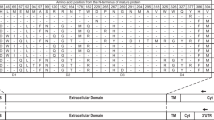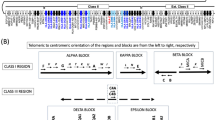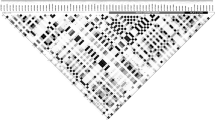Abstract
The Killer Immunoglobulin-like Receptor (KIR) proteins constitute a family of highly homologous surface receptors involved in the regulation of the innate cytotoxicity of natural killer (NK) cells. Within the human genome, 17 KIR genes are present, many of which show large variation across the population owing to the high number of allelic variants and copy number variation (CNV). KIR genotyping and CNV determination were used to map the KIR locus in a large cohort of >400 Caucasian individuals. Gene order and structure was determined by sequence-specific polymerase chain reaction of the intergenic regions. In this way, we could show that KIR3DL1 and KIR2DS4 gene variants are linked and that—contrary to current views—the gene KIR2DS5 is only present in the telomeric half of the KIR locus. Our study revealed novel insights in the highly organized distribution of KIR genes. Novel recombination hotspots were identified that contribute to the diversity of KIR gene distribution in the Caucasian population. Next-generation sequencing of the KIR intergenic regions allowed for a detailed single-nucleotide polymorphism analysis, which demonstrated several gene-specific as well as haplotype-specific nucleotides for a more accurate genotyping of this notoriously complex gene cluster.
This is a preview of subscription content, access via your institution
Access options
Subscribe to this journal
Receive 6 digital issues and online access to articles
$119.00 per year
only $19.83 per issue
Buy this article
- Purchase on Springer Link
- Instant access to full article PDF
Prices may be subject to local taxes which are calculated during checkout






Similar content being viewed by others
References
O'Leary JG, Goodarzi M, Drayton DL, von Adrian UH . T cell- and B cell-independent adaptive immunity mediated by natural killer cells. Nat Immunol 2006; 7: 507–516.
Paust S, Senman B, Von Andrian UH . Adaptive immune responses mediated by natural killer cells. Immunol Rev 2010; 235: 286–296.
Béziat V, Liu LL, Malmberg JA, Ivarsson MA, Sohlberg E, Björklund AT et al. NK cell responses to cytomegalovirus infection lead to stable imprints in the human KIR repertoire and involve activating KIRs. Blood 2013; 121: 2678–2688.
Kunert K, Seiler M, Mashreghi MF, Klippert K, Schönemann C, Neumann K et al. KIR/HLA Ligand incompatibility in kidney transplantation. Transplantation 2007; 84: 1527–1533.
Ruggeri L, Capanni M, Urbani E, Perruccio K, Shlomchik WD, Tosti A et al. Effectiveness of donor natural killer cell alloreactivity in mismatched hematopoietic transplants. Science 2002; 295: 2097–2100.
van Bergen J, Thompson A, Haasnoot GW, Roodnat JI, de Fijter JW, Claas FHJ et al. KIR-Ligand mismatches are associated with reduced long-term graft survival in HLA-compatible kidney transplantation. Am J Transplant 2011; 11: 1959–1964.
Venstrom JM, Zheng J, Noor N, Danis KE, Yeh AW, Cheung IY et al. KIR and HLA genotypes are associated with disease progression and survival following autologous hematopoietic stem cell transplantation for high-risk neuroblastoma. Clin Cancer Res 2009; 15: 7330–7334.
Trowsdale J . Genetic and functional relationships between MHC and NK receptor genes. Immunity 2001; 15: 363–374.
Hsu KC, Chida S, Geraghty DE, Dupont B . The killer cell immunoglobulin-like receptor (KIR) genomic region: gene-order, haplotypes and allelic polymorphism. Immunol Rev 2002; 190: 40–52.
Uhrberg M, Valiante NM, Shum BP, Shilling HG, Lienert-Weidenbach K, Corliss B et al. Human diversity in killer cell inhibitory receptor genes. Immunity 1997; 7: 753–763.
Jiang W, Johnson C, Jayaraman J, Simecek N, Noble J, Moffatt MF et al. Copy number variation leads to considerable diversity for B but not A haplotypes of the human KIR genes encoding NK cell receptors. Genome Res 2012; 22: 1845–1854.
Vendelbosch S, de Boer M, Gouw RATW, Ho CKY, Geissler J, Swelsen WTN et al. Extensive variation in gene copy number at the killer immunoglobulin-like receptor locus in humans. PLoS ONE 2013; 8: e67619.
Pyo CW, Guethlein LA, Vu Q, Wang R, Abi-Rached L, Norman PJ et al. Different patterns of evolution in the centromeric and telomeric regions of group A and B haplotypes of the human killer cell Ig-like receptor locus. PLoS ONE 2010; 5: e15115.
Hsu KC, Chida S, Geraghty DE, Dupont B . The killer cell immunoglobulin-like receptor (KIR) genomic region: gene-order, haplotypes and allelic polymorphism. Immunol Rev 2002; 190: 40–52.
Vierra-Green C, Roe D, Hou L, Hurley CK, Rajalingam R, Reed E et al. Allele-level haplotype frequencies and pairwise linkage disequilibrium for 14 KIR loci in 506 European-American individuals. PLoS ONE 2012; 7: e47491.
Shilling HG, Young N, Guethlein LA, Cheng NW, Gardiner CM, Tyan D et al. Genetic control of human NK cell repertoire. J Immunol 2002; 169: 239–247.
Martin M, Single R, Wilson M, Trowsdale J, Carrington M . KIR haplotypes defined by segregation analysis in 59 Centre d'Etude Polymorphisme Humain (CEPH) families. Immunogenetics 2008; 60: 767–774.
Pando MJ, Gardiner CM, Gleimer M, McQueen KL, Parham P . The protein Madm from a common Aalele of KIR3DL1 (3DL1*004) is poorly expressed at cell surfaces due to substitution at positions 86 in Ig domain 0 and 182 in Ig domain 1. J Immunol 2003; 171: 6640–6649.
Gonzalez-Galarza FF, Christmas S, Middleton D, Jones AR . Allele frequency net: a database and online repository for immune gene frequencies in worldwide populations. Nucleic Acids Res 2011; 39: D913–D919.
Gomez-Lozano N, Gardiner C, Parham P, Vilches C . Some human KIR haplotypes contain two KIR2DL5 genes: KIR2DL5A and KIR2DL5B. Immunogenetics 2002; 54: 314–319.
van Heeringen SJ, Veenstra GJ . GimmeMotifs: a de novo motif prediction pipeline for ChIP-sequencing experiments. Bioinformatics 2010; 27: 270–271.
Davies GE, Locke SM, Wright PW, Li H, Hanson RJ, Miller JS et al. Identification of bidirectional promoters in the human KIR genes. Genes Immun 2007; 8: 245–253.
Li H, Pascal V, Martin MP, Carrington M, Anderson SK . Genetic control of variegated KIR gene expression: polymorphisms of the bi-directional KIR3DL1 promoter are associated with distinct frequencies of gene expression. PLoS Genet 2008; 4: e1000254.
Presnell SR, Zhang L, Ramilo CA, Chan HW, Lutz CT . Functional redundancy of transcription factor-binding sites in the killer cell Ig-like receptor (KIR) gene promoter. Int Immunol 2006; 18: 1221–1232.
Trompeter HI, Gómez-Lozano N, Santourlidis S, Eisermann B, Wernet P, Vilches C et al. Three structurally and functionally divergent kinds of promoters regulate expression of clonally distributed killer cell Ig-like receptors (KIR), of KIR2DL4, and of KIR3DL3. J Immunol 2005; 174: 4135–4143.
vanBergen J, Stewart CA, vandenElsen PJ, Trowsdale J . Structural and functional differences between the promoters of independently expressed killer cell Ig-like receptors. Eur J Immunol 2005; 35: 2191–2199.
Gómez-Lozano N, Trompeter HI, de Pablo R, Estefanía E, Uhrberg M, Vilches C . Epigenetic silencing of potentially functional KIR2DL5 alleles: implications for the acquisition of KIR repertoires by NK cells. Eur J Immunol 2007; 37: 1954–1965.
Gómez-Lozano N, Estefanía E, Williams F, Halfpenny I, Middleton D, Solís R et al. The silent KIR3DP1 gene (CD158c) is transcribed and might encode a secreted receptor in a minority of humans, in whom the KIR3DP1, KIR2DL4 and KIR3DL1/KIR3DS1 genes are duplicated. Eur J Immunol 2005; 35: 16–24.
Martin MP, Bashirova A, Traherne J, Trowsdale J, Carrington M . Cutting edge: expansion of the KIR locus by unequal crossing over. J Immunol 2003; 171: 2192–2195.
Trundley AE, Hiby SE, Chang C, Sharkey AM, Santourlidis S, Uhrberg M et al. Molecular characterization of KIR3DL3. Immunogenetics 2006; 57: 904–916.
Norman P, Cook M, Carey BS, Carrington C, Verity D, Hameed K et al. SNP haplotypes and allele frequencies show evidence for disruptive and balancing selection in the human leukocyte receptor complex. Immunogenetics 2004; 56: 225–237.
Giebel S, Nowak I, Wojnar J, Krawczyk-Kulis J, Holowiecki J, Kyrc-Krzemien P et al. Association of KIR2DS4 and its variant KIR1D with leukemia. Leukemia 2008; 22: 2129–2130.
Cichocki F, Miller JS, Anderson SK, Bryceson YT . Epigenetic regulation of NK cell differentiation and effector functions. Front Immunol 2013; 4: 55.
Uhrberg M . Shaping the human NK cell repertoire: an epigenetic glance at KIR gene regulation. Mol Immunol 2005; 42: 471–475.
Norman PJ, Hollenbach JA, Nemat-Gorgani N, Guethlein LA, Hilton HG, Pando MJ et al. Co-evolution of human leukocyte antigen (HLA) class I ligands with killer-cell immunoglobulin-like receptors (KIR) in a genetically diverse population of sub-Saharan Africans. PLoS Genet 2013; 9: e1003938.
Traherne JA, Martin M, Ward R, Ohashi M, Pellett F, Gladman D et al. Mechanisms of copy number variation and hybrid gene formation in the KIR immune gene complex. Hum Mol Genet 2010; 19: 737–751.
Batzer MA, Deininger PL . Alu repeats and human genomic diversity. Nat Rev Genet 2002; 3: 370–379.
Du Z, Sharma SK, Spellman S, Reed EF, Rajalingam R . KIR2DL5 alleles mark certain combination of activating KIR genes. Genes Immun 2008; 9: 470–480.
Yawata M, Yawata N, Draghi M, Little AM, Partheniou F, Parham P . Roles for HLA and KIR polymorphisms in natural killer cell repertoire selection and modulation of effector function. J Exp Med 2006; 203: 633–645.
Gardiner CM, Guethlein LA, Shilling HG, Pando M, Carr WH, Rajalingam R et al. Different NK cell surface phenotypes defined by the DX9 antibody are due to KIR3DL1 gene polymorphism. J Immunol 2001; 166: 2992–3001.
Hall TA . BioEdit: a user-friendly biological sequence alignment editor and analysis program for Windows 95/98/NT. Nucleic Acids Symp Ser 1999; 41: 95–98.
Acknowledgements
This research was supported by the Sanquin Blood Supply Foundation, The Netherlands, Grant number PPOC-09-018. The funders had no role in study design, data collection and analysis, decision to publish or preparation of the manuscript.
Author Contributions
SV designed and performed experiments and analyzed the data; MdB, KvL, FP and JG performed experiments; and TKvdB and TWK provided intellectual input. All authors contributed to writing the manuscript.
Author information
Authors and Affiliations
Corresponding author
Ethics declarations
Competing interests
The authors declare no conflict of interest.
Additional information
Supplementary Information accompanies this paper on Genes and Immunity website
Supplementary information
Rights and permissions
About this article
Cite this article
Vendelbosch, S., de Boer, M., van Leeuwen, K. et al. Novel insights in the genomic organization and hotspots of recombination in the human KIR locus through analysis of intergenic regions. Genes Immun 16, 103–111 (2015). https://doi.org/10.1038/gene.2014.68
Received:
Revised:
Accepted:
Published:
Issue Date:
DOI: https://doi.org/10.1038/gene.2014.68



